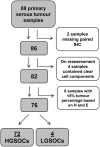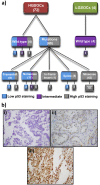Assessing mutant p53 in primary high-grade serous ovarian cancer using immunohistochemistry and massively parallel sequencing
- PMID: 27189670
- PMCID: PMC4870633
- DOI: 10.1038/srep26191
Assessing mutant p53 in primary high-grade serous ovarian cancer using immunohistochemistry and massively parallel sequencing
Abstract
The tumour suppressor p53 is mutated in cancer, including over 96% of high-grade serous ovarian cancer (HGSOC). Mutations cause loss of wild-type p53 function due to either gain of abnormal function of mutant p53 (mutp53), or absent to low mutp53. Massively parallel sequencing (MPS) enables increased accuracy of detection of somatic variants in heterogeneous tumours. We used MPS and immunohistochemistry (IHC) to characterise HGSOCs for TP53 mutation and p53 expression. TP53 mutation was identified in 94% (68/72) of HGSOCs, 62% of which were missense. Missense mutations demonstrated high p53 by IHC, as did 35% (9/26) of non-missense mutations. Low p53 was seen by IHC in 62% of HGSOC associated with non-missense mutations. Most wild-type TP53 tumours (75%, 6/8) displayed intermediate p53 levels. The overall sensitivity of detecting a TP53 mutation based on classification as 'Low', 'Intermediate' or 'High' for p53 IHC was 99%, with a specificity of 75%. We suggest p53 IHC can be used as a surrogate marker of TP53 mutation in HGSOC; however, this will result in misclassification of a proportion of TP53 wild-type and mutant tumours. Therapeutic targeting of mutp53 will require knowledge of both TP53 mutations and mutp53 expression.
Figures







References
-
- Soussi T. & Wiman K. G. Shaping genetic alterations in human cancer: the p53 mutation paradigm. Cancer Cell 12, 303–312 (2007). - PubMed
Publication types
MeSH terms
Substances
LinkOut - more resources
Full Text Sources
Other Literature Sources
Medical
Research Materials
Miscellaneous

